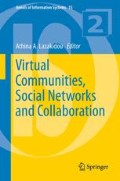Abstract
A Markov random field (MRF) is composed of 2D or 3D Markov chains providing spatial homogeneity in some sense. Markov random fields are reviewed and investigated as models of that kind of models. In a matter of graphs, spatial interactions between nodes defining local conditionals in regions denote Markov networks. These models are the set of sites, with a certain probability structure to the possible labeling of those sites.
Physical properties of the neighbors could be explained by partial differential equation (PDE) inside the potential function introducing PDE-MRF models. In Bayesian analysis, they have been used to describe the local characteristics of the spatial interaction between sites introducing Bayesian networks. A social network is a social structure constructing nodes, which are connected by one or more specific types of interdependency. When the nodes are explained by conditional probability modeling between them, in that case a connection between MRF and social networks could be established, to identify the local connectivity.
In this work, spatial behavior of the MRF models in nonrectangular lattice would be investigated. MRF models called PDE-MRF models are introduced based on the total variation of the region, considering smoothness assumptions. Finally, the Markov assumptions to deal with social network models are generalized and are discussed; some classes of estimations have been introduced using the Gibbs sampler.
Access this chapter
Tax calculation will be finalised at checkout
Purchases are for personal use only
References
Anderson, C., Wasserman, S., & Crouch, B. (1999). A p* primer: Logit models for social networks. Social Networks, 21, 37–66.
Aykroyd, R., Haigh, J. G. B., & Zimeras, S. (1996). Unexpected spatial patterns in exponential family auto-models. Graphical Models and Image Processing, 58, 452–463.
Aykroyd, R. G., & Green, P. J. (1991). Global and local priors and the location of lesions using gamma-camera imagery. Philosophical Transactions of the Royal Society Series A, 337, 323–342.
Aykroyd, R. G., & Zimeras, S. (1999). Inhomogeneous prior models for image reconstruction. Journal of American Statistical Association (JASA), 94(447), 934–946.
Besag, J. (1974). Spatial interaction and the statistical analysis of lattice systems (with discussion). Journal of the Royal Statistical Society: Series B, 36, 192–236.
Besag, J. (1986). On the statistical analysis of dirty pictures (with discussion). Journal of the Royal Statistical Society: Series B, 48, 259–302.
Chandler, D. (1978). Introduction to modern statistical mechanics. New York: Oxford University Press.
Cross, G. R., & Jain, A. K. (1983). Markov random field texture models. IEEE Transactions on Pattern Analysis and Machine Intelligence, 5(1), 25–39.
Diggle, P. J. (1983). Statistical analysis of spatial pattern point. London: Academic Press.
Frank, O., & Strauss, D. (1986). Markov graphs. Journal of the American Statistical Association, 81, 832–842.
Geman, S., & Geman, D. (1984). Stochastic relaxation, Gibbs distributions, and Bayesian restoration of images. IEEE Transactions on Pattern Analysis and Machine Intelligence, 6, 721–741.
Green, P. J. (1990). Bayesian reconstructions from emission tomography data using a modified EM algorithm. IEEE Transactions on Medical Imaging, 9, 84–93.
Green, P. J., & Han, X. L. (1992). Metropolis methods, Gaussian proposals and antithetic variables. Lecture Notes in Statistics, 74, 142–164.
Haindl, M. (1991). Texture synthesis. CWI Quarterly, 4, 305–331.
Hamersley, J. A., & Clifford, P. (1971). Markov fields on finite graphs and lattices. Unpublished work.
Hastings, W. K. (1970). Monte Carlo simulation methods using Markov chains, and their applications. Biometrika, 57, 97–109.
Ising, E. (1925). Beitrag zur Theorie des Ferromagnetismus. Zeitschrift für Physik, 31, 253–258.
Kindermann, R., & Snell, J. L. (1980). Markov random fields and their applications. Providence, RI: American Mathematical Society.
Li, S. (1995). Markov random fields in computer vision. New York: Springer.
Metropolis, N., Rosenbluth, A., Rosenbluth, M., Teller, A., & Teller, E. (1953). Equations of state calculations by fast computing machines. Journal of Chemical Physics, 21, 1087–1091.
Poston, T., & Stewart, I. (1978). Catastrophe theory and its applications. London: Pitman.
Qian, W., & Titterington, D. M. (1991). Multidimensional Markov chain model for image texture. Journal of the Royal Statistical Society: Series B, 53, 661–674.
Ranngarajan, A., & Chellappa, R. (1995). Markov random fields models in image processing. In M. Arbib (Ed.), The handbook of brain theory and neural networks (pp. 564–567). Cambridge, MA: MIT Press.
Ripley, B. D., & Sutherland, A. I. (1990). Finding spiral structures in images of galaxies. Philosophical Transactions of the Royal Society Series A, 332, 477–485.
Smith, A. F. M., & Robert, G. O. (1993). Bayesian computation via the Gibbs sampler and related Markov chain Monte Carlo methods. Journal of the Royal Statistical Society: Series B, 55, 3–23.
Spitzer, F. (1971). Markov random fields and Gibbs ensembles. The American Mathematical Monthly, 78, 142–154.
Taskar, B., Abbeel, P., & Koller, D. (2002, August). Discriminative probabilistic models for relational data. In Proceedings of the 18th conference on uncertainty in artificial intelligence (pp. 485–492). San Francisco: Morgan Kaufmann.
Wasserman, S., & Pattison, P. (1996). Logit models and logistic regression for social networks: I. An introduction to Markov graphs and p*. Psychometrika, 61, 401–425.
Weir, I. S. (1993). Statistical modeling and reconstructions in single photons emission computed tomography. Ph.D. thesis, Bristol University, Bristol, UK.
Zhang, J. (1992). The mean field theory in EM procedures for Markov random fields. IEEE Transactions on Signal Processing, 40(10), 2570–2583.
Zimeras, S. (1997). Statistical models in medical image analysis. Ph.D. thesis, Leeds University, Leeds, UK.
Zimeras, S. (2006). Simulating texture patterns using auto-logistic models. WSEAS Transactions on Systems, 5(10), 2269–2276.
Zimeras, S., & Georgiakodis, F. (2005). Bayesian models for medical image biology using Monte Carlo Markov chain techniques. Mathematical and Computer Modeling, 42(2005), 759–768.
Author information
Authors and Affiliations
Corresponding author
Editor information
Editors and Affiliations
Rights and permissions
Copyright information
© 2012 Springer Science+Business Media New York
About this chapter
Cite this chapter
Zimeras, S. (2012). Markov Random Field and Social Networks. In: Lazakidou, A. (eds) Virtual Communities, Social Networks and Collaboration. Annals of Information Systems, vol 15. Springer, New York, NY. https://doi.org/10.1007/978-1-4614-3634-8_11
Download citation
DOI: https://doi.org/10.1007/978-1-4614-3634-8_11
Published:
Publisher Name: Springer, New York, NY
Print ISBN: 978-1-4614-3633-1
Online ISBN: 978-1-4614-3634-8
eBook Packages: Computer ScienceComputer Science (R0)

